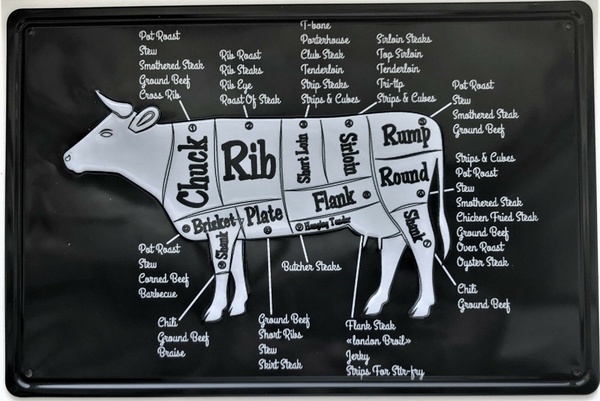
Beef Chuck
Beef chuck comes from the forequarter. Consisting of parts of the neck, shoulder blade, and upper arm, beef chuck produces tough but very flavorful cuts of meat.
This primal cut has a good deal of connective tissue. That makes chuck a good choice for braised dishes like beef stew or pot roast, both of which tenderize tough cuts. Due to its fat content, beef chuck is also excellent for making ground beef that produces juicy burgers and ground beef stew.
Beef Rib
Made from the top part of the center section of rib—specifically the sixth through the twelfth ribs— the beef rib primal cut is used for the traditional standing rib roast (also called prime rib). It’s also the source of the delectable ribeye steak as well as the classic French entrecôte.
Since they’re already tender, steaks and roasts from the beef rib primal can undergo various forms of dry-heat cooking and remain tender.
It’s nearly impossible to describe a beef primal cut without discussing adjacent cuts. In this case, the beef rib primal is situated directly above the beef plate. Exactly where it’s divided is somewhat arbitrary. Nevertheless, the lower parts of those ribs—whether we attribute them to the rib primal or the plate primal—are where beef short ribs come from.
Beef Brisket
Beef brisket is one of the most flavorful cuts of meat, although it is tough and needs to be cooked in just the right way. It’s also a moderately fatty cut of beef, but this can work to your advantage because it tenderizes into succulent, meaty perfection.
Taken from the area around the breastbone, the brisket is basically the chest or pectoral muscle of the animal. The characteristically thick, coarse-grained meat needs a lot of time and low-temperature cooking to break down and tenderize.
Brisket is frequently used for making pot roast, and it’s the traditional choice for corned beef. Another very popular technique for preparing brisket is to slow cook it in a barbecue or smoker.
Beef Shank
The beef shank is the leg of the animal’s thigh. Each side of beef has two shanks, one in the forequarter and one in the hindquarter. It is extremely tough and full of connective tissue.
Beef shank is used in making the luxurious Italian dish osso buco.
Beef Short Loin
Moving on to the beef primal cuts from the hindquarter, or back of the animal, the short loin is where we find the most desirable cuts of meat. These include T-bone and porterhouse steaks, as well as the strip loin or strip steak.
The beef short loin is only about 16 to 18 inches long. It will yield anywhere from 11 to 14 steaks, depending on thickness.
The steaks from the short loin are cut starting at the rib end and working toward the rear. The first-cut steaks are club steaks or bone-in strip steaks. The center-cut steaks are T-bones, of which there may be six or seven. Finally, a butcher may be able to get two or three porterhouse steaks at the sirloin end.
The tenderloin extends from the short loin back into the sirloin. It’s interesting to note that if the tenderloin is removed, there can be no T-bone or porterhouse steaks. Both of these steaks include a section of the tenderloin muscle.
Dry-heat cooking is best for the tender cuts from the short loin.
Beef Sirloin
The full sirloin is itself subdivided into top sirloin and bottom sirloin. Top sirloin is generally fabricated into steaks that are good for grilling. Since the sirloin is closer to the rear leg of the animal, the muscles get a bit tougher. Still, a first-cut sirloin steak—sometimes called a pin-bone steak because it includes a section of the hip bone—is very similar to a porterhouse.
Beef Tenderloin
The most tender cut of beef is the beef tenderloin and it is found within the loin. This is where we get filet mignon, which is made from the very tip of the pointy end of the tenderloin. Chateaubriand is made from the center cut of the tenderloin.
The tenderloin extends from the short loin into the sirloin. The pointy end is actually situated within the short loin, and the section in the sirloin is sometimes called the butt tenderloin. Even so, butchers will often remove the entire tenderloin and sell it whole or as individual steaks and roasts.
Beef tenderloin should only be cooked using dry-heat methods, such as grilling and broiling. The meat is already super tender, so long cooking times are unnecessary. Keep it quick and the heat high.
Beef Flank
Beef flank can be cooked on the grill. Since it has tough muscle fibers, it can get even tougher if it’s overcooked, so be careful.
The best technique for flank steak is to grill it quickly at a high temperature. Marinating the meat first can help prevent it from drying out, but avoiding overcooking really is the best prevention. When you’re ready to serve it, remember to slice this steak thinly against the grain so it isn’t chewy.
Beef flank is also good for braising and it’s often used for making ground beef.
Sources:
https://www.thespruceeats.com/cuts-of-beef-chuck-loin-rib-brisket-and-more-995304